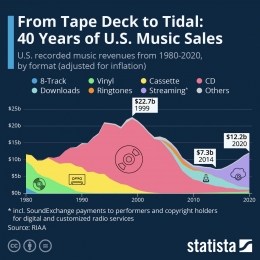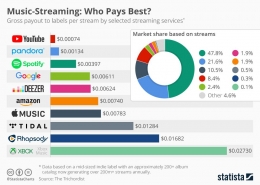OECD Statistics Directorate (2002) defined consumer surplus as a measure of consumer welfare that equates to the excess of social valuation over the actual product price. In the music world, consumer surplus is the gap between the price of a song and a consumer's willingness to pay for the song.
Since the rise of music streaming, studies have shown that consumer surplus also rose. Equist, Goodridge, and Haskel (2021) have found that in the US, the shift from CD to streaming has resulted in a price decrease of 85% per song. From this decrease, US consumers approximately derive a $1B annual consumer surplus (Brynjolfsson, Hu, & Smith, 2003; Waldfogel, 2017).
The second explanation for the preferability of music streaming is due to the network effect. The network effect occurs when a streaming platform offers its additional services to steer consumers towards complementary goods and services (Towse, 2020). For instance, streaming services that offer a free listening option such as Spotify and Pandora tend to promote their subscription packages to their users. This subscription is usually accompanied by a distinguishing feature that makes it better than the free package, for instance, no advertisements and no limitations on the number of "skips". Thus, even though users have to pay for a subscription, their experience will also be enhanced because they have received an added value. Going back to why streaming is preferable to illegal music sites, these added values are usually nonexistent on illegal music sites which is precisely why streaming services are preferable.
How Streaming Makes Music Production More Affordable
Besides reducing piracy, the rise of streaming services has also reduced the cost of music production for artists. Waldfogel (2015) states that for only about $10, an artist can make their song available on iTunes. In comparison, the cost of producing music before the era of music streaming was roughly around $1M per album for a new artist, which is equivalent to $100,000 per song if an album contains 10 songs (Vogel, 2007).
The cost difference of producing music between pre-streaming (hereinafter referred to as the traditional model) and during the streaming era, lies in the difference in the cost per process. The International Federation of the Phonographic Industries (2010) explains that the traditional model follows three key steps. Firstly, a record label identifies a promising talent to sign into their label. For example, in 2008, Scooter Braun from RMBG Records discovered Justin Bieber on YouTube and signed him to the label (CNN, 2019). Second, the record label will invest in producing the artist's music using professional and expensive equipment. Lastly, the record label will begin producing music videos and other promotional content, as well as distributing physical albums.
With free computer software for editing music and inexpensive equipment, Waldfogel (2017) argues that the cost of producing music is becoming more affordable than ever. Moreover, the emergence of streaming services also helps independent artists–artists who are not signed by any record labels–to make their music available on streaming platforms such as Spotify and Apple Music in licensing, distribution, and administration processes (Spotify for Artists, 2022; Apple Music for Artists, 2022).
The Cost of Streaming: Is Streaming a Modern-Day Slavery?
Despite the growth of the streaming industry and the benefits that come with it, profit-share remains a concern for artists all over the world. In 2020, the American rapper Kanye West voiced his concern about the lack of profit he made from Spotify. With 14-25% of royalties not being received at the time, West claimed that Spotify was "modern-day slavery" (Laker, 2021). Furthermore, artists in the UK and Norway seem to be having the same problem. Even though music revenue in the UK in 2020 reached 1B, artists were only paid as little as 13% of the revenue. In Norway, despite the growth of music streaming from 5% in 2011 to 14% in 2017, physical sales fell from 10% to 9% and the share of composers and performers fell from 29% to 24% (The Norwegian Ministry of Culture, 2019). Hence, why do streaming services pay so little to their artists?

Before considering the determinants of payout per stream, it is important to note that the amount of money paid from a streaming service to its artists may differ because each platform has its own systems. For example, Graph 1 shows that YouTube Music pays as little as $0.00074/stream, Spotify pays $0.0097/stream, while Apple Music pays as much as $0.00783/stream.
Towse (2017) explains that streaming revenue (payout per stream) is influenced by the streaming platform's main source of income; subscription fees and advertisement fees. The amount of money that a streaming platform gets from subscription fees depends on the price it sets for a subscription package. To set the price, streaming platforms will analyze the market's willingness to pay based on the data they have of their users such as but not limited to gender, age, and interests (Ezrachi and Stucke, 2019). Because the user demography of each streaming platform may differ, so will their willingness to pay, hence the variety of subscription fees.












